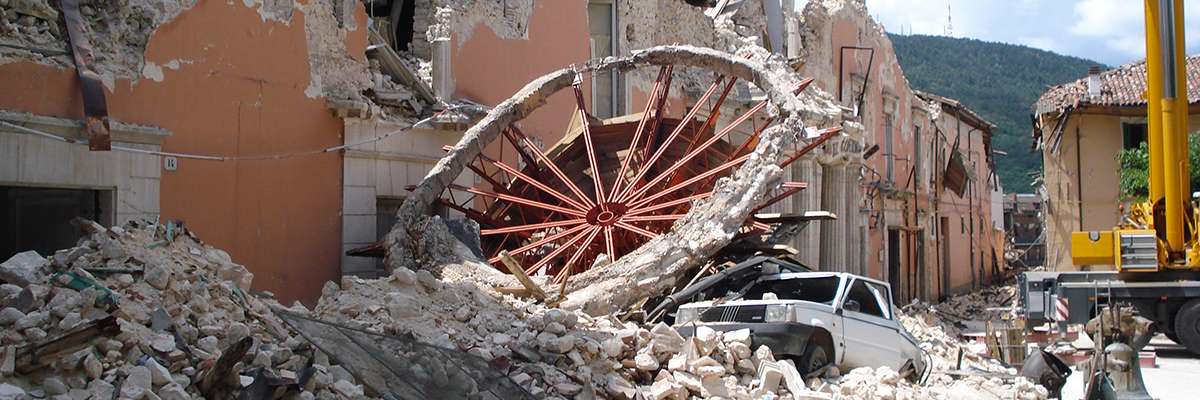
The Alpine cross-border region is not immune to a major seismic disaster. Preparing for the consequences of such an event on the population, the economy and the environment of the Alpine valleys is an essential mission of all the regional players contributing to the management of the seismic risk. The RISVAL project proposes to strengthen the abilities of these actors to characterise the risk, quickly estimate seismic intensities and develop shared tools to qualify the vulnerability of constructions. An Interreg France-Italy Alcotra project.
Although the cross-border region is subject to moderate seismic activity, its increasing anthropisation has considerably changed is seismic vulnerability. Moderate earthquakes can particularly affect structures allowing trade between France and Italy. Whether it is a question of performing preventive work or on the contrary in the emergency of an earthquake, it is necessary to define and develop effective tools and procedures adapted to regional specificities and shared for seismic risk management. This presupposes, in particular, a better understanding of the phenomenon and its impact on the region, along with the strengthening of the risk culture - including the awareness and involvement of the general public -, or the definition of the conditions of use of the structures according to their damage.
The project aims to address the following challenges: (a) create common database structures for the collection and integration of all data available in the region to improve knowledge and integrated management of seismic risk; (b) develop an innovative and advanced cross-border surveillance system; (c) define cross-border strategies to reduce the seismic risk through the implementation of specific procedures for emergency management in the event of an earthquake, analysis of the vulnerability of buildings and strategic infrastructures; (d) define dissemination, education and communication instruments suited to the intended target.
1. Cross-border shared databases structure
The project covers the acquisition and management of a large volume of data relating to seismic hazards at the regional (seismicity catalogue, attenuation models) and local (soil-related amplifications) levels, to exposure of the issues and their vulnerability (distribution and response of constructions to earthquakes).
2. Integrated cross-border approach for monitoring the physical vulnerability of buildings
Establishment of the conditions necessary for the preventive implementation of building vulnerability diagnostics, from the harmonisation of diagnostic practices to their banking and sharing, as well as for the definition of the methods of valuing these data in order to allow greater efficiency in the implementation of emergency diagnostics in the hours/days following the occurrence of an earthquake. In parallel to this, the behaviour under seismic stress of buildings or strategic infrastructures (e.g.: access ramp to the Mont Blanc tunnel in Chamonix) will be assessed out in pilot areas.
3. Cross-border strategies for reducing the seismic risk
These will be based on the implementation of tools and procedures dedicated to crisis management, and on the definition of guidelines for carrying out reinforcement actions in order to reduce the vulnerability of constructions.
4. Increasing the cross-border culture of seismic risk
The project will raise the awareness of regional stakeholders involved in the operational management of seismic risk to the major associated issues and will strongly involve them in the definition of technical and organisational solutions allowing them to eventually provide an effective response. The project also plans to address the general public in order to promote the active role of citizens in the field of prevention.
Cerema is involved more specifically in two areas:
-
Better consideration of the observed seismic site effects in the alpine valleys of the Alpes Maritimes department for the production of near-real-time strong movement prediction maps (shakemaps): the Cerema teams' knowledge of the terrain and the experience in this field will provide the information required to improve the shakemaps currently produced in the region.
-
Estimation of the vulnerability of road engineering structures by carrying out <i>in situ</i> seismological measurements on the A51 engineering structures and the viaduct of the access ramp to the Mont-Blanc tunnel. (Egratz viaduct)
-
France: ISTERRE, BRGM, GEOAZUR (CNRS), Entente-Valabre
-
Italy: Valle d'Aosta region, Piedmont region, ARPA Piedmont

You have a question ?

